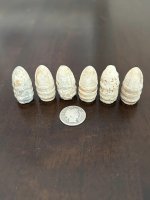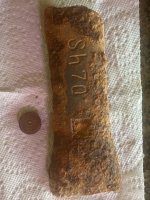bahamamike
Jr. Member
- Feb 5, 2012
- 46
- 7
- Primary Interest:
- Shipwrecks
Antiquities, Monuments & Museum Corporation of The Bahamas
Mel Fisher Maritime Heritage Society
Atlantic Sea Resources
PHOTO CAPTIONS:
0023: Key West archaeologist Corey Malcom from the Mel Fisher Maritime Heritage Society uncovers granite ballast stones from under the sand with an underwater vacuum.
0047: Bahamian Archaeologist Michael Pateman from the Antiquities, Monuments & Museum Corporation of The Bahamas, uses an underwater vacuum to clear sand away from potential wreckage.
0128: Bahamian Archaeologist Kelly Delancy documents Mel Fisher Maritime Heritage Society archaeologist Corey Malcom recovering artifacts from the slave ship, Peter Mowell.
SLAVE SHIP ARTIFACTS FOUND AT LYNYARD CAY
On craggy rocks and in silent gullies at Lynyard Cay in the Abacos lay the fragments of an American-owned slave ship, the 129-ton, 88-foot schooner, the Peter Mowell.
Luckily, 390 of the 400 of its human cargo were able to clamber safely ashore – they were quite young: 96 men between 20 and 36 years, 37 women between 20 and 30 years, and 256 children between 6 and 20 years. Thanks to the ever-changing winds of fate, though, they were not to be sold as slaves like the estimated 12-million Africans forced across the Atlantic over the course of the three-and-a-half century slave-trade era. Rather, rescued by Ridley Pinder and other wreckers from Cherokee Sound, they joined some of the last of the 37,000 African-born immigrants who had been rescued in The Bahamas, whose descendants most likely make their homes there today.
But what is left of the ship intrigued archaeologist Michael Pateman from the Antiquities, Monuments & Museum Corporation of The Bahamas, a Nassau-based, non-profit, quasi-government agency, and archaeologist Corey Malcom from the Key West, Fl.-based Mel Fisher Maritime Heritage Society and more importantly – because the information gleaned will add to The Bahamas’ rich cultural history – what happened to its human cargo, crew and wreckers? Where are their descendants now and what stories do they have to tell?
So, on the 152[SUP]nd[/SUP] anniversary of its wreck, July 25, 1860, and partnering with William Mathers, of the Florida-based marine archaeological organization, Atlantic Sea Resources, they set out to see for themselves. Using coordinates recorded by the governor of The Bahamas at the time (Bayley) to the Duke of Newcastle, they returned to the site and were able to spot piles of ballast stones that were scattered along the shoreline as its hull was ripped apart on the reefs, along with encrusted copper nails and spikes that had become concretized together over a century and a half.
“Everything that we see from the wreck matches what we know from accounts of the Peter Mowell,” Malcom said. “Although the environment at Lynyard Cay is more harsh than we anticipated, and the preservation of the site is not as good as we had hoped, we feel confident that we have found the remains of the wreck of the Peter Mowell. This provides a tangible reality and a remarkable story from the slave trade era and provides a subsequent starting point to search for the descendants of these African refugees, crews and wreckers.”
“This research expedition is an early step of an ongoing project to develop an exhibit studying aspects of Bahamian slave history at the Pompey Museum in Nassau, through a grant from the Templeton Foundation,” Pateman said. “The Peter Mowell entails far more than finding an actual wreck; It gives us the opportunity to learn the story about these liberated Africans, the people who rescued them, the slave traders and all of their descendants.”
“The history of the Bahamas is fascinating, and the Peter Mowell wreck is a particularly compelling story. It’s exciting to reawaken it and make it public knowledge,” Malcom said.
“We want to present a story of Bahamian history that hasn’t been told before and needs to be told, so that we can learn more about the history of our Islands and its rich heritage,” Pateman said.
The successful location of the wreck of the slaver Peter Mowell promises to open a new chapter in the archaeology and history of The Bahamas and the transatlantic slave trade; it could allow modern Bahamians to trace their roots to the site and remains of a particular slave ship. Any Bahamian descendants of the Peter Mowell survivors or wreckers who have knowledge of this shipwreck, please contact Michael Pateman at 242-326-2566.
“What we have is the opportunity to link families descended from the survivors of this event -- from the Africans, the wreckers and the slave-ship crew,” Malcom said. “Our ultimate goal is to bring the members of these families together.”
For more information, contact:
Michael Pateman
Archaeologist, Antiquities, Monuments & Museums Corporation of the Bahamas
242-326-2566
[email protected]
Welcome to the Antiquities Monuments & Museums Corporation
Mel Fisher Maritime Heritage Society
Atlantic Sea Resources
PHOTO CAPTIONS:
0023: Key West archaeologist Corey Malcom from the Mel Fisher Maritime Heritage Society uncovers granite ballast stones from under the sand with an underwater vacuum.
0047: Bahamian Archaeologist Michael Pateman from the Antiquities, Monuments & Museum Corporation of The Bahamas, uses an underwater vacuum to clear sand away from potential wreckage.
0128: Bahamian Archaeologist Kelly Delancy documents Mel Fisher Maritime Heritage Society archaeologist Corey Malcom recovering artifacts from the slave ship, Peter Mowell.
SLAVE SHIP ARTIFACTS FOUND AT LYNYARD CAY
On craggy rocks and in silent gullies at Lynyard Cay in the Abacos lay the fragments of an American-owned slave ship, the 129-ton, 88-foot schooner, the Peter Mowell.
Luckily, 390 of the 400 of its human cargo were able to clamber safely ashore – they were quite young: 96 men between 20 and 36 years, 37 women between 20 and 30 years, and 256 children between 6 and 20 years. Thanks to the ever-changing winds of fate, though, they were not to be sold as slaves like the estimated 12-million Africans forced across the Atlantic over the course of the three-and-a-half century slave-trade era. Rather, rescued by Ridley Pinder and other wreckers from Cherokee Sound, they joined some of the last of the 37,000 African-born immigrants who had been rescued in The Bahamas, whose descendants most likely make their homes there today.
But what is left of the ship intrigued archaeologist Michael Pateman from the Antiquities, Monuments & Museum Corporation of The Bahamas, a Nassau-based, non-profit, quasi-government agency, and archaeologist Corey Malcom from the Key West, Fl.-based Mel Fisher Maritime Heritage Society and more importantly – because the information gleaned will add to The Bahamas’ rich cultural history – what happened to its human cargo, crew and wreckers? Where are their descendants now and what stories do they have to tell?
So, on the 152[SUP]nd[/SUP] anniversary of its wreck, July 25, 1860, and partnering with William Mathers, of the Florida-based marine archaeological organization, Atlantic Sea Resources, they set out to see for themselves. Using coordinates recorded by the governor of The Bahamas at the time (Bayley) to the Duke of Newcastle, they returned to the site and were able to spot piles of ballast stones that were scattered along the shoreline as its hull was ripped apart on the reefs, along with encrusted copper nails and spikes that had become concretized together over a century and a half.
“Everything that we see from the wreck matches what we know from accounts of the Peter Mowell,” Malcom said. “Although the environment at Lynyard Cay is more harsh than we anticipated, and the preservation of the site is not as good as we had hoped, we feel confident that we have found the remains of the wreck of the Peter Mowell. This provides a tangible reality and a remarkable story from the slave trade era and provides a subsequent starting point to search for the descendants of these African refugees, crews and wreckers.”
“This research expedition is an early step of an ongoing project to develop an exhibit studying aspects of Bahamian slave history at the Pompey Museum in Nassau, through a grant from the Templeton Foundation,” Pateman said. “The Peter Mowell entails far more than finding an actual wreck; It gives us the opportunity to learn the story about these liberated Africans, the people who rescued them, the slave traders and all of their descendants.”
“The history of the Bahamas is fascinating, and the Peter Mowell wreck is a particularly compelling story. It’s exciting to reawaken it and make it public knowledge,” Malcom said.
“We want to present a story of Bahamian history that hasn’t been told before and needs to be told, so that we can learn more about the history of our Islands and its rich heritage,” Pateman said.
The successful location of the wreck of the slaver Peter Mowell promises to open a new chapter in the archaeology and history of The Bahamas and the transatlantic slave trade; it could allow modern Bahamians to trace their roots to the site and remains of a particular slave ship. Any Bahamian descendants of the Peter Mowell survivors or wreckers who have knowledge of this shipwreck, please contact Michael Pateman at 242-326-2566.
“What we have is the opportunity to link families descended from the survivors of this event -- from the Africans, the wreckers and the slave-ship crew,” Malcom said. “Our ultimate goal is to bring the members of these families together.”
For more information, contact:
Michael Pateman
Archaeologist, Antiquities, Monuments & Museums Corporation of the Bahamas
242-326-2566
[email protected]
Welcome to the Antiquities Monuments & Museums Corporation





